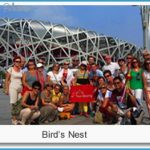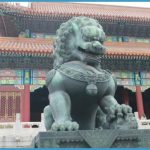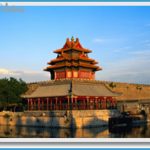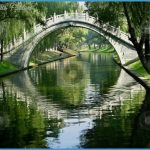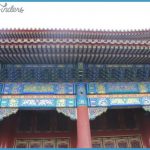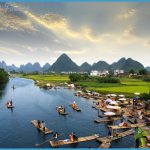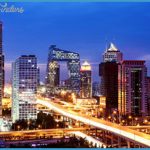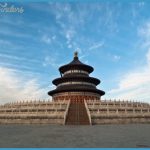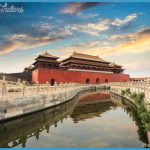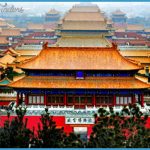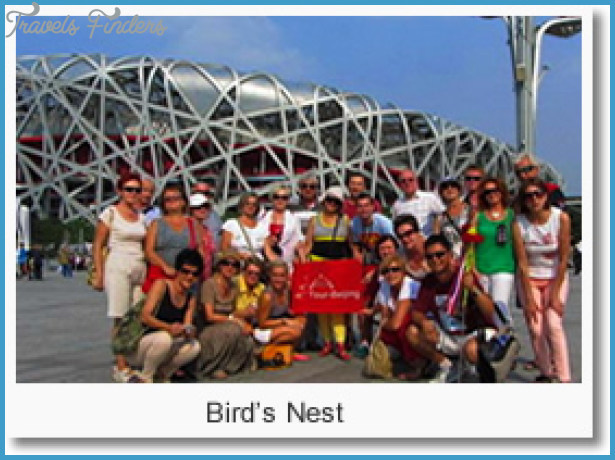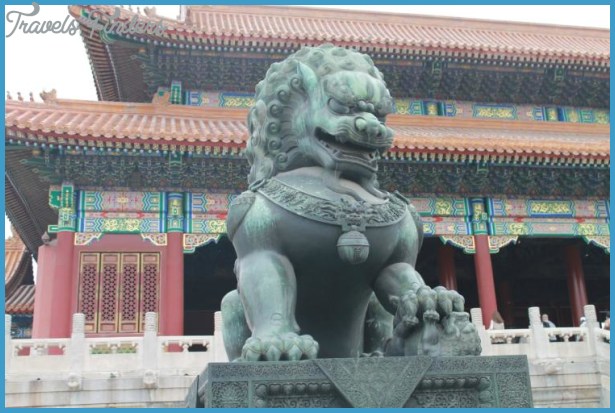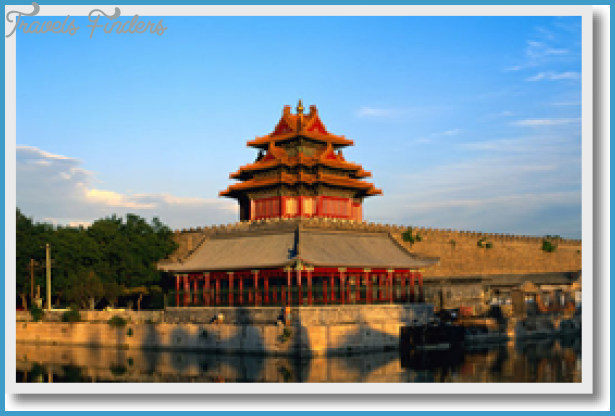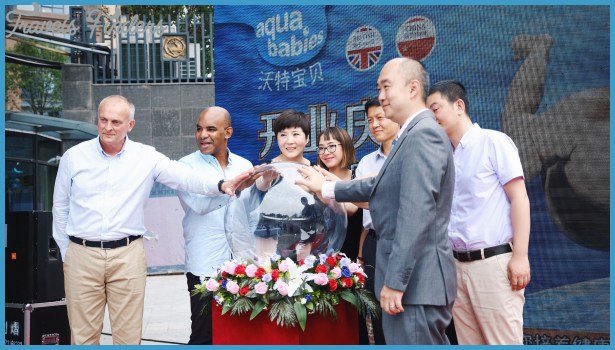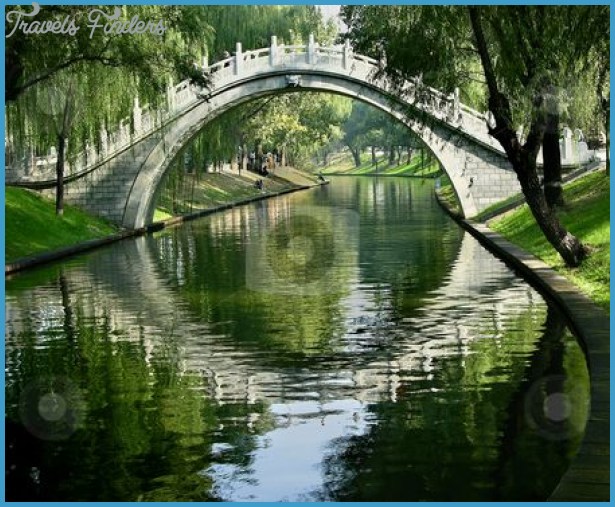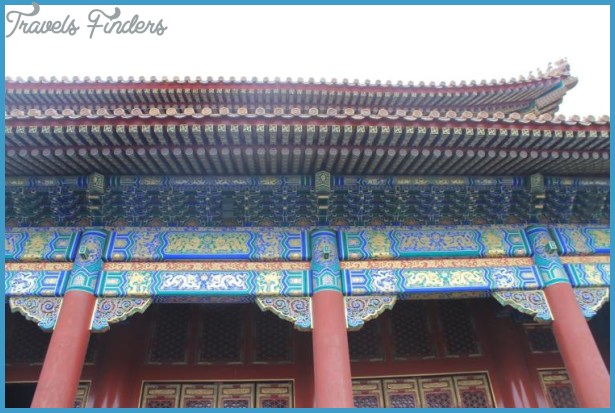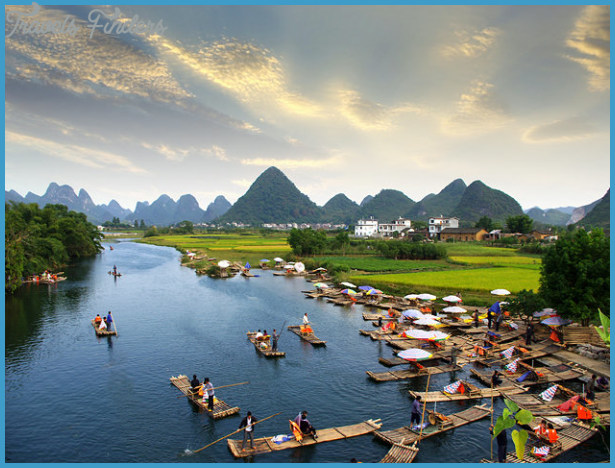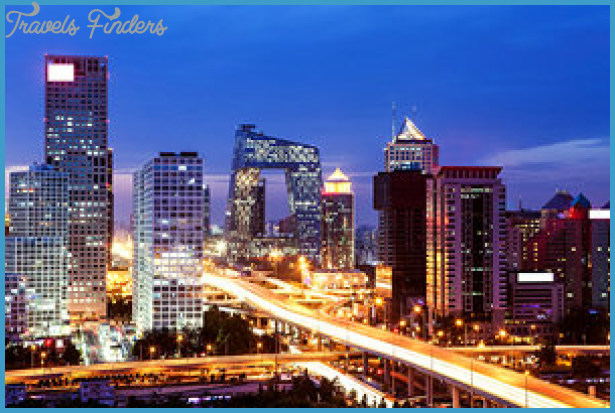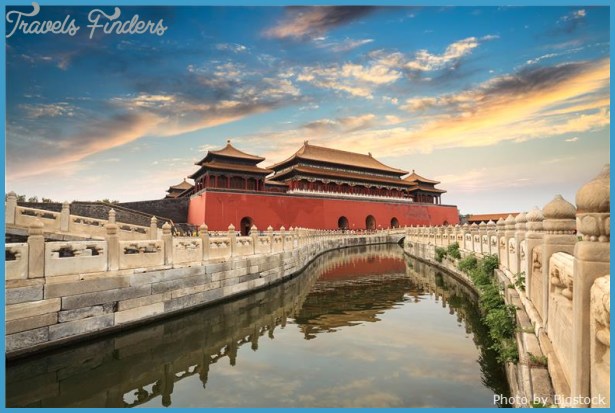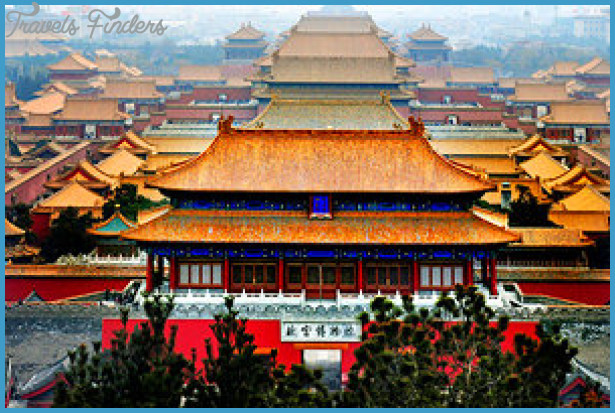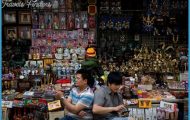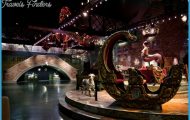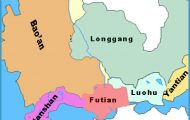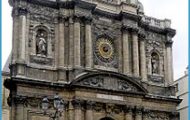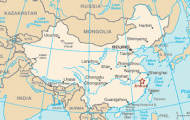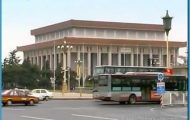The Park ofthe Beautiful View lies just a short distance north ofthe Imperial Palace. The hill in the centre of the park was named “coal hill” (Meisham), because under the Ming emperors (1368-1644) coal was stored at the foot of this hill. In 1416 during the construction of the Imperial Palace, the dumping of rubble from the old city wall and large quantities of soil from excavation of the moat surrounding the imperial palace, resulted in the naturally low-lying mound soaring in height. By the south gate is the Tower ofthe Beautiful View.
Under Emperor Qianlong who reigned from 1735 to 1796, pavilions were built on the five hilltops, and these still remain standing today. The middle and highest of them is called the Pavilion of Eternal Spring. From this pavilion a picturesque view of the city centre and the Imperial Palace can be enjoyed. To the Chinese it is therefore also known as the Hill of the Beautiful View.
At the south-eastern foot of the hill is the old acacia on which the last Ming emperor reportedly hanged himself on March 17th 1644.
In the north ofthe park complex is the Hall of Imperial Longevity, also built by the Emperor Qianlong.
The North Lake Park measures 680,OOOsq.m/813,280sq.yd (open: winter 6.30am-8.30pm, summer 6am-9pm). It lies to the north-west ofthe Imperial Palace and to the west ofthe Park ofthe Beautiful View. It is one ofthe oldest imperial gardens in Beijing. The park was laid out at the beginning of the 10th c. Its name is taken from Lake Beihai (north lake) which is situated here. The name north lake was adopted because it joins the lakes Zhonghai (middle lake), and Nanhai (south lake), in the south. On the south lake is the seat of the state council and its Central Committee of the Communist Party.
When the Jin rulers dug outtheXihuaTan lake in the 12th c.the Island of Exquisite Jade was created, and the Guanghan Gong Palace was built on it. The Round City, which lies at the southern point of the lake was the centre ofthe capital Dadu in the Yuan period (1271-1368). Many ofthe buildings still standing today date from the time of Emperor Qianlong (reigned 1735-96).
The park, which is surrounded by a high wall, has become one of Beijing’s favourite recreational venues. Access can be gained through the south, north, and east gates.
We arrive next at the 4500sq.m/5382sq.yd Round City, which dates from the Yuan period (1271-1368), and is situated near the south gate. It lies behind a 5m/161/!ft wall built in the 15th c. Many of the present buildings were erected by Emperor Qianlong (1735-96).
The main attraction ofthe park is the Hall of Enlightenment (1690). A niche in the rear section of the palace conceals a splendid Buddha, standing 1.5m/5ft high, and carved from one single block of white jade. It was apparently brought from Burma to Beijing in the reign of Emperor
At the front of the hall is a pavilion, which houses and protects a large black jade vase from the early 12th c. It stands 60cm/24in. above the ground, measures 1.5m/5ft in diameter, weighs 3500kg/7717lb and is decorated with representations of dragons and sea creatures. It was discovered in 1745 and four years later the Emperor Qianglong had the pavilion built for its safe keeping. According to archaeologists it is the largest jade vessel ever to be found in China. According to tradition Kublai Khan used it for storing wine.
Crossing the Bridge of Eternal Peace (Yong’an Qiao) which dates from the Yuan period (1271-1368), we reach the Island of Exquisite Jade (Qionghua Dao), on which once stood the Palace of Guanghan Gong, built under the Mongol ruler Kublai Khan.
In 1651 the Temple of Eternal Peace was built on the palace ruins, the buildings extending across the hill. On the way up is the Shanyin Dian Hall with its yellow and green glazed tiles and 455 niches housing Buddhas.
Behind the temple rises the 40m/131ft high Tibetan style White Pagoda, also built in 1651, on the occasion of the visit of the Dalai to Beijing. The pagoda was destroyed by an earthquake in 1651, was rebuilt a few years later and restored under the Emperor Qianlong. On its south side is a niche bearing a red emblem, which apparently served as a storing place for sacred objects.
Covered steps lead down the north slope to the covered Yilan Tang path which is richly decorated with paintings.
Also situated hereisthe Fangshan restaurant which serves specialities of Imperial cuisine.
In the south-west ofthe island it is worth visiting the Yuan Lou pavilion which houses a collection of manuscripts.
The north bank ofthe lake can be reached by ferry. Here can be seen the Five-Dragon Pavilions (1602), connected by stone bridges.
To the north of these is the Zhenguan Hall with the Iron Wall which dates back to the Yuan period. It is made from volcanic stone and stands almost 2m/6ft high and 3.5m/11ft long. Further to the west is the Pavilion of the Little Western Heaven (Xiaoxitian) of the Qianglon period and to the north of this the Botanical Gardens and the Tower of Ten-thousand Buddhas (Wanfo Lou)
The Nine Dragon Wall (1417) in the north is 5m/16ft high and 27m/29ft long. It is decorated in seven colours with representations of nine dragons.
In the northern corner ofthe lake is the Silkworm Altar (Can Tan). Further south are the studio on a painted boat (Huafang Zhai) and the pavilion between the rivers Hao and Pu (Haopu Ting), both from the Qianlong period.
This popular park, lying south-west of the Imperial Palace, was opened to the public in 1914. In 1928 it was renamed the Sun-Yat-sen Park. Emperor Yongle had the Sheji Tan altar built in the park grounds in 1421. From then onwards the emperors made sacrifices here twice-yearly, in the springtime to bring a good harvest and in the autumn for thanksgiving. The altar still stands and is situated in the centre ofthe park. The Xili Ting Pavilion in the south of park once housed the ceremonial chamber.
The white gate was originally dedicated to the memory of Baron von Ketteler, who was assassinated in the Boxer Rebellion. However, following
In the Temple of Heaven the German defeat in the First World War, the inscription was changed to “Justice Triumphs” and later to “Defend the Peace”. This was written by Guo Moruo (See Famous People).
In the Stele Pavilion nearby can be seen an 18th c. stele which originally stood in the Garden of Perfection and Light (Yuanmin Yuan).
Also situated nearby is the Water Pavilion, once a meeting place for scholars and poets The Flail of Prayer (north ofthe altar), which was renamed Sun-Yat-sen Flail in 1928, is 550 years old and consequently Beijing’s oldest well-preserved wooden building.
The Culture Park ofthe Workers, which lies to the south-east of the Imperial Palace, was originally the Imperial Temple of Ancestors, constructed by order of Emperor Yongle in 1420. Today it is open to the public for leisure and cultural activities. Film and theatre performances, exhibitions, concerts and sporting activities all take place here.
From the south gate the actual temple compound is entered through a three-arched gate and through the Daji Men gate. Three halls are placed one in front ofthe other. In the First Hall (Taimiao) ceremonies of ancestor worship took place. In the Middle Hall (Zhongdian) were kept the rolls of honour of deceased emperors-the rolls were brought out only for ceremonies which took place in the First Hall – and the Rear Hall (Houdian) forms the conclusion of the temple area.

